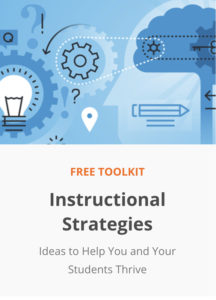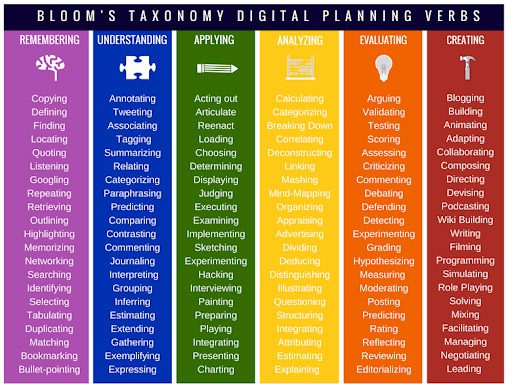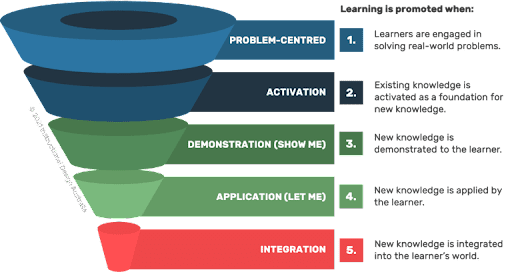The importance of learning in any situation cannot be overstated. After all, how else do we improve our skills?
Our early lives and childhood revolve around learning and gaining skills to prepare us for later life. But too often, learning becomes less of a priority after leaving full-time education. Many of us become less willing to learn new things.
How, then, can educators ensure that learning delivers an experience that will make people come back for more?
You’ll want to make sure your training is aimed at meeting people’s needs and that it delivers on its promises. But how can you provide the best learning experiences for your students and other learners?
For a start, you’ll need an instructional design model.
What Is an Instructional Design Model?

A learning experience could be face-to-face teaching, preparation for an important test, a one-off presentation, or a fully fledged course. Whether you’re teaching a degree course or training office workers in a new partner relationship management system, you need an instructional design model to build the experience around.
The result will be more engaging learning experiences for your learners. This helps to foster a culture of learning which improves people’s esteem and stokes a desire to learn more. But what model should you choose? To the uninitiated, the differences between each can be confusing. Here are five examples of instructional design models that might help you.
1. ADDIE
This is an instructional model that was originally developed for the armed forces. Its flexibility, however, has meant that it has been taken on by many different organizations.
The name is derived from the five stages of the model: Analysis, Design, Development, Implementation, and Evaluation. Together, these stages can create effective training and learning experiences.
Let’s look at each of the five phases.
Analysis
The first stage of the model is to perform a needs analysis. This involves looking at the knowledge that learners already possess. From there, you can begin creating objectives for your activity that can help build upon this knowledge. Ask some simple questions. What is your timeline for delivery? Are there any learning constraints? What are your options for delivery?
Design
Here, you begin creating learning objectives, planning lessons, and considering other elements that will make up your learning experience.
Each step in design planning should support your overall objectives. You could be teaching Physics, in which case your objectives might include the clear explanation of fundamental principles. Or, you could be running a course on famous women in technology, where an objective might be to deliver an understanding of the impact that each has made.
You’ll need input from key people in your organization and wider, so consider VoIP software as a cost-effective communication tool to stay in touch.
Create storyboards, prototypes, and if necessary, a user interface. At this stage, you should have a clear idea of the visual elements that will make up your learning experience.
Development
As the name suggests, this is when you begin to create the components that were planned during the design process. During this phase you should also carry out tests and receive feedback.
Implementation
The implementation phase involves training the educators. It’s where you ensure that they have a full understanding of curriculums, learning outcomes, and all of the different elements that make up a course.
Evaluation
The final phase in course design is made up of two parts: Formative and summative evaluation. Formative evaluation should be present at every stage of the ADDIE model. After you’ve completed a phase, make sure that it lines up with your overall goals. Cloud hosted systems could help you to keep all relevant documentation organized and easily accessible.
Summative evaluation takes place after development has been completed. It involves assessing the course in its entirety to verify that it meets learning goals.
2. Bloom’s Taxonomy
Bloom’s Taxonomy is another popular model that has a long history of success. This model helps to categorize the different skills that an educator wants a student to learn and outlines the objective for doing so. Bloom’s Taxonomy is made up of six categories:
Remembering
This is the most basic level of learning. It involves asking students to memorize facts and repeat them. Students could be asked to repeat facts or quote information from previous lessons. Tests or multiple-choice questions will often be used to gauge how effectively learning from earlier modules has been retained.
Understanding
A learner may have memorized a fact, but do they understand it? This phase of the model involves testing whether a learner can place information within an appropriate context and explain it. During this phase, you may ask students to explain or summarize important aspects of the course.
Applying
This stage takes a learner out of the learning environment and into the real world. Can they apply what they’ve learned in a practical manner?
Analyzing
This element of the taxonomy is about making greater sense of what’s been learned. Learners may get asked to break down the steps of a complicated process or identify the interlinked causes of a problem.
Evaluating
The evaluation stage involves asking students to consider the information that they have learned. Is it valuable? Can they identify the difference between facts and opinions? How can this information be used to overcome problems?
Creating
In this final stage, learners must demonstrate their knowledge by creating something. This could involve writing a paper, revising processes, or creating a manual. Their creation should apply their learning from each of the phases.
3. Gagne’s Nine Events of Instruction
 The nine events outlined in this model can be a great way of creating strategies and activities that can be used for instruction. Each step can form part of a framework for providing a learning experience:
The nine events outlined in this model can be a great way of creating strategies and activities that can be used for instruction. Each step can form part of a framework for providing a learning experience:
- Gaining attention – As the name suggests, do something to draw attention. This could be through surprising your learners or presenting an intriguing problem.
- Informing learners of objectives – Let students know learning goals and the knowledge that they should gain by the end of the class.
- Stimulating recall of prior learning – This can help students learn new information by relating new facts to old knowledge.
- Presenting the stimulus – Present information in bitesize, manageable ways. Use text graphics and other forms of stimuli to support the learning of new facts.
- Providing learning guidance – Offer one-on-one tutorials (perhaps with the aid of a cloud phone system for remote learning); provide case studies and other examples that will help guide learners.
- Eliciting performance – Run activities to encourage students to use their new knowledge.
- Providing feedback – Once a learner has gained their knowledge, provide instant feedback. Outline areas of success and those that need improvement.
- Assessing performance – Carry out tests to see how well students have achieved their expected learning outcomes.
- Enhancing protection and transfer – In the final stage, you should make sure that students can internalize any new knowledge. This could be through the creation of mind maps or creating summaries.
4. Action Mapping
This is a particularly useful model for creating training programs for people who want to work in the business world. Action mapping takes a much more visual approach to instructional design. Reminiscent of a mind map, a user identifies and plots out desired goals, and the skills required to reach them.
Cathy Moore, the model’s creator, outlined three core goals of action mapping. The first commits to measurably improving performance. The second identifies a problem and the best solution to it. The third focuses training around practical activity rather than simply presenting information.
Action mapping helps to identify those parts of a process where the necessary actions are not being taken. It allows process owners to understand why this is the case and create a plan for overcoming the issue.
5. Merrill’s Principles of Instruction
This model outlines four phases of learning, all of which build upon the idea that learning is problem-centered. It also outlines tasks that can be used in conjunction with the four. The phases identified in Merrill’s Principles of Instruction are:
Activation: A learner will likely already have some knowledge of a subject. Learning materials should awaken this knowledge, so that it can be built upon with additional information. Recommend reading materials that will engage and inform can help here. For example, if you are running a business course you could assign top management books.
Demonstration: The educator will show techniques to illustrate information. This could be through videos or infographics.
Application: Students should now be able to use the knowledge that they have gained for problem-solving.
Integration: Once training is complete, learners should be encouraged to use information that they have learned in their day-to-day lives. Various asynchronous communication methods might be used to follow up with learners.
Which Model Should You Choose?
There are numerous models, and each has its own list of benefits. So, which should you choose?
Begin by looking at the kind of learning experience that you want to create, and continue from there. Are you planning in-person instruction or a remote course? Each of the models should enable you to create more streamlined and engaging learning experiences.
Take time to assess your needs, then choose a model. When the benefits of learning are so obvious, why wait?
See also:





